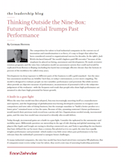Thinking Outside the Nine-Box: Future Potential Trumps Past Performance
The competition for talent to lead industrial companies in the current era of innovation and transformation is so fierce, it’s easy to forget that talent has been considered central to organizational success for decades. In the 1980’s, Jack Welch declared himself “the world’s highest-paid HR executive” because of the emphasis he placed on hiring, assessment and development. He made extensive rotation programs and the nine-box evaluation model an assessment system that could and would be replicated from Boston to Beijing (including his harsh but seemingly effective dictate that the bottom 10 percent of the workforce be culled every year).
Development via deep exposure to different parts of the business is still a gold standard – but the nine-box assessment model has an Achilles’ heel that, in today’s environment, is ever-more crippling. The model is designed to evaluate people on two variables: performance and potential. But while metrics often provide an objective measure of performance, measurement of potential is left to the subjective judgement of the evaluator—with the frequent end result that people who show high performance are assumed to also have high potential for future growth.
A knife in a gun fight
When the nine-box model was first adopted, Asia was increasingly asserting itself as a manufacturer and exporter, and the beginnings of globalization was forcing developed countries to recognize new competitors and new rules of doing business; but the strategic mandate to “build a better product at a lower price” remained more or less the same. Because of this, assuming someone’s future performance would match their previous track record was a pretty safe bet. Organizations needed steady, incremental gains, and the nine-box model was structured to identify who would deliver.
Today though, incremental gains are a knife in a gun fight. Consider the upheaval in the automotive and mobility space. Millennials question car ownership in the age of ride sharing and global warming; tech players like Apple and Google are racing to develop connected cars, and Tesla is upending the mechanics that have defined the car for more than a century. But plotted as it is on a grid, the nine-box equally weights performance and potential—which makes very little sense when past performance is far less relevant than the individual’s potential to navigate future challenges.
At many industrial companies, the nine-box model has been hard-wired into enterprise HR platforms. But if companies want to win today’s war for talent, they need a new way of assessing leadership potential.
This need led us to develop an alternative—a quantitative approach that identifies four characteristics of potential that indicate a leader’s ability to adapt and thrive in uncertain, quickly changing environments. By focusing on curiosity, insight, engagement and determination, we are able to identify leaders with the DNA for success in disruptive times.
A round peg in a square box
There’s a final—and surprising—reason that the nine-box assessment is past its prime: The model was never intended to assess people in the first place. It was adapted from an earlier framework developed for GE in the 1970s, to help it evaluate which of its many businesses warranted further investment and which should be sold. Perhaps that’s why, even though the model has long been an HR standard, it’s never been very much loved by the people being evaluated. It may make sense to categorize businesses by putting them in different boxes, but there’s a much better way to predict true leadership potential.






